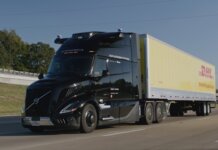The Biden-Harris administration has released the National Zero-Emission Freight Corridor Strategy. Developed by the Joint Office of Energy and Transportation and U.S. Department of Energy (DOE), in collaboration with the Department of Transportation (DOT) and the Environmental Protection Agency (EPA), the strategy will guide the deployment of zero-emission medium- and heavy-duty vehicle (ZE-MHDV) charging and hydrogen fueling infrastructure from 2024 to 2040.
This strategy is designed to meet growing market demands by targeting public investment to amplify private sector momentum, focus utility and regulatory energy planning, align industry activity and improve air quality in local communities heavily impacted by diesel emissions.
“For over a century, petroleum-fueled freight has transported vital food and resources to American families, but at the same time, these vehicles have also contributed to lower public health, especially in densely populated communities,” says U.S. Secretary of Energy Jennifer M. Granholm. “The Biden-Harris administration is addressing this issue head-on with innovative strategies to transform freight so it not only supports American families and businesses, but also protects the environment for future generations.”
“This is a big move to deliver environmental justice — 75 percent of heavy truck traffic travels on just 4 percent of our nation’s roads, jeopardizing the health of our most vulnerable communities,” says Ali Zaidi, President Biden’s National Climate Advisor. “President Biden’s historic investments in zero-emission infrastructure on those high-traffic roads and the hubs they connect will rapidly transform freight transport in the U.S. and strengthen American innovation. Through the president’s whole-of-government strategy, this administration is delivering a win-win-win for frontline communities that will benefit from cleaner air, businesses that will save millions on fuel costs and for our climate.”
Providing ubiquitous and convenient access to electric vehicle charging and hydrogen refueling along U.S. freight corridors and at intermodal freight facilities and high-usage ports is key to achieving the nation’s goals to promote at least 30% ZE-MHDV sales by 2030 and 100% sales by 2040.
The goal of the strategy is to align public policy and investments by prioritizing, sequencing and accelerating infrastructure along the National Highway Freight Network (NHFN) in four phases. A core objective of the strategy is to meet freight truck and technology markets where they are now, determine where they are likely to develop next, and set an ambitious pathway that mobilizes actions to achieve decarbonization.
In alignment with the Joint Office’s National Zero-Emission Freight Corridor Strategy, the Federal Highway Administration is announcing the designation of National EV Freight Corridors along the National Highway Freight Network and other key roadways. The designations, which are required by the Bipartisan Infrastructure Law (BIL), are a critical part of the Biden-Harris administration’s strategy for building out a convenient, reliable and made-in-America national EV charging network that supports individual drivers and commercial needs.
“The Federal Highway Administration is pleased to announce these new freight EV corridor designations along our national highways,” says Federal Highway Administrator Shailen Bhatt. “Medium- and heavy-duty trucks in our current freight network contribute approximately 23 percent of greenhouse gas emissions in the U.S. transportation sector. These new designations and strategy will help to grow our national EV charging network, encourage clean commerce within the freight community, and support President Biden’s goals of achieving net-zero emissions for the nation by 2050.”
Under Biden’s leadership, the number of publicly available EV chargers nationwide has increased by more than 80% to more than 173,000, and at least 40 U.S.-based facilities to produce EV chargers have been announced or opened. Biden’s Investing in America agenda has attracted more than $25 billion of investment in the U.S. EV charging network.
The National Zero-Emission Freight Corridor Strategy will prioritize, sequence and accelerate infrastructure along key freight corridors and hubs in four phases. The phases include:
- Establish priority hubs based on freight volumes (2024-2027)
- Connect hubs along critical freight corridors (2027-2030)
- Expand corridor connections initiating network development (2030-2035)
- Achieve national network by linking regional corridors for ubiquitous access (2035-2040)
See the National Zero-Emission Freight Corridor Strategy for additional maps and details.





